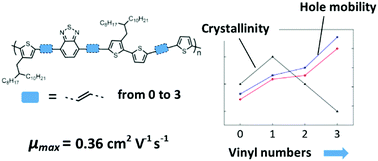In this work we aim to investigate the relationships among the ratios of vinyl linker, crystallinity and charge carrier mobility in a series of benzothiadiazole–quarterthiophene based conjugated polymers. Four polymers, PB4TV0, PB4TV1, PB4TV2 and PB4TV3, containing 0 to 3 vinyl linkers in the repeating unit were synthesized, and their corresponding bottom gate/bottom contact organic field effect transistors were fabricated and examined. The results manifest escalating hole mobilities along the increasing ratio of vinyl linker, with PB4TV3 reaching a high hole mobility up to 0.36 cm2 V−1 s−1. On the other hand, further investigations have revealed a gradual reduction in the crystallinity with rising vinyl ratio after a slight enhancement at first. The difference between the mobility and crystallinity variation tendency is caused by the combined influences of intra-chain charge transport enhancement and the conformational isomerization nature of the vinyl linker, which could provide new thoughts in designing high performance conjugated polymers for OFETs in future.

